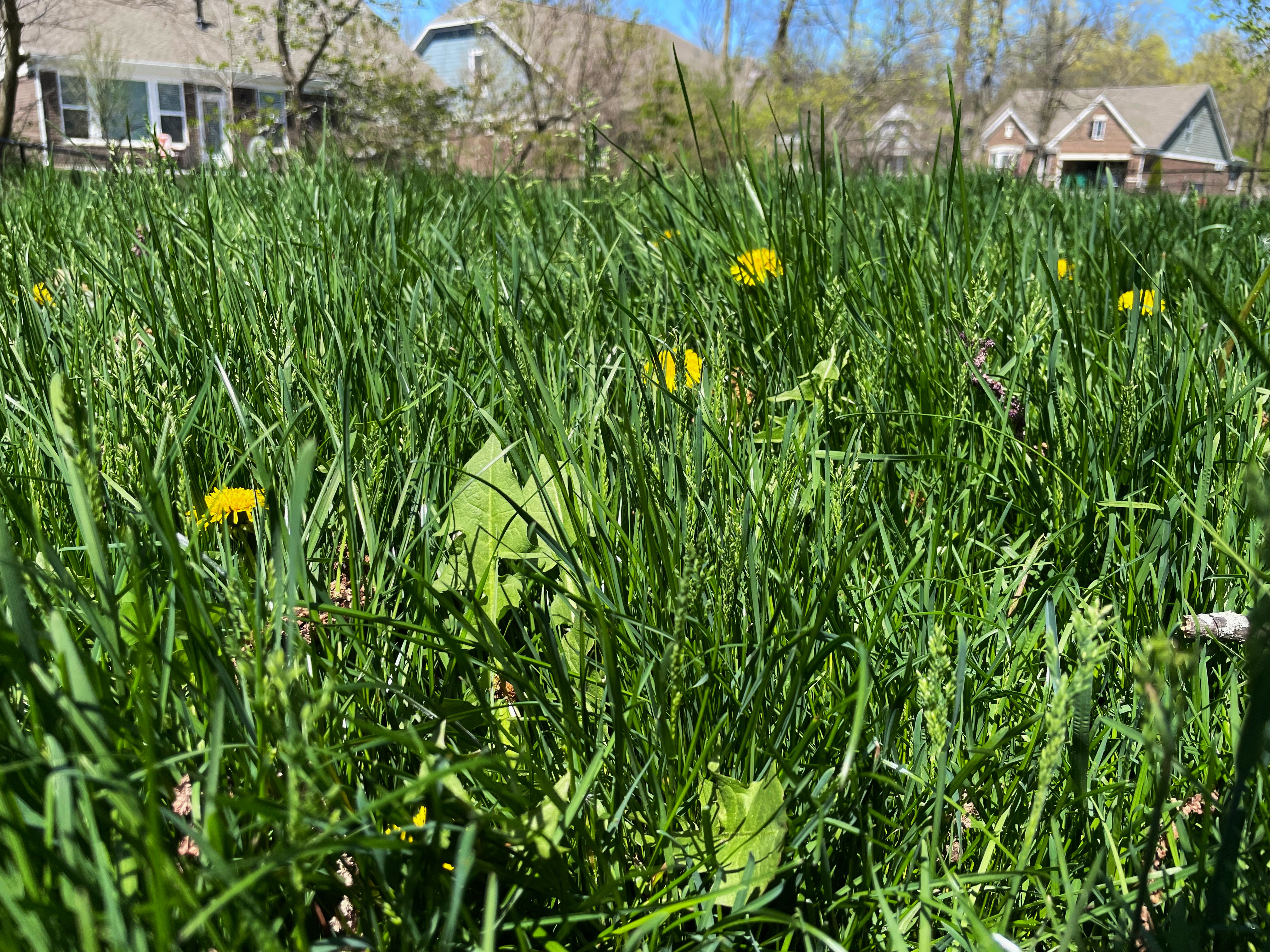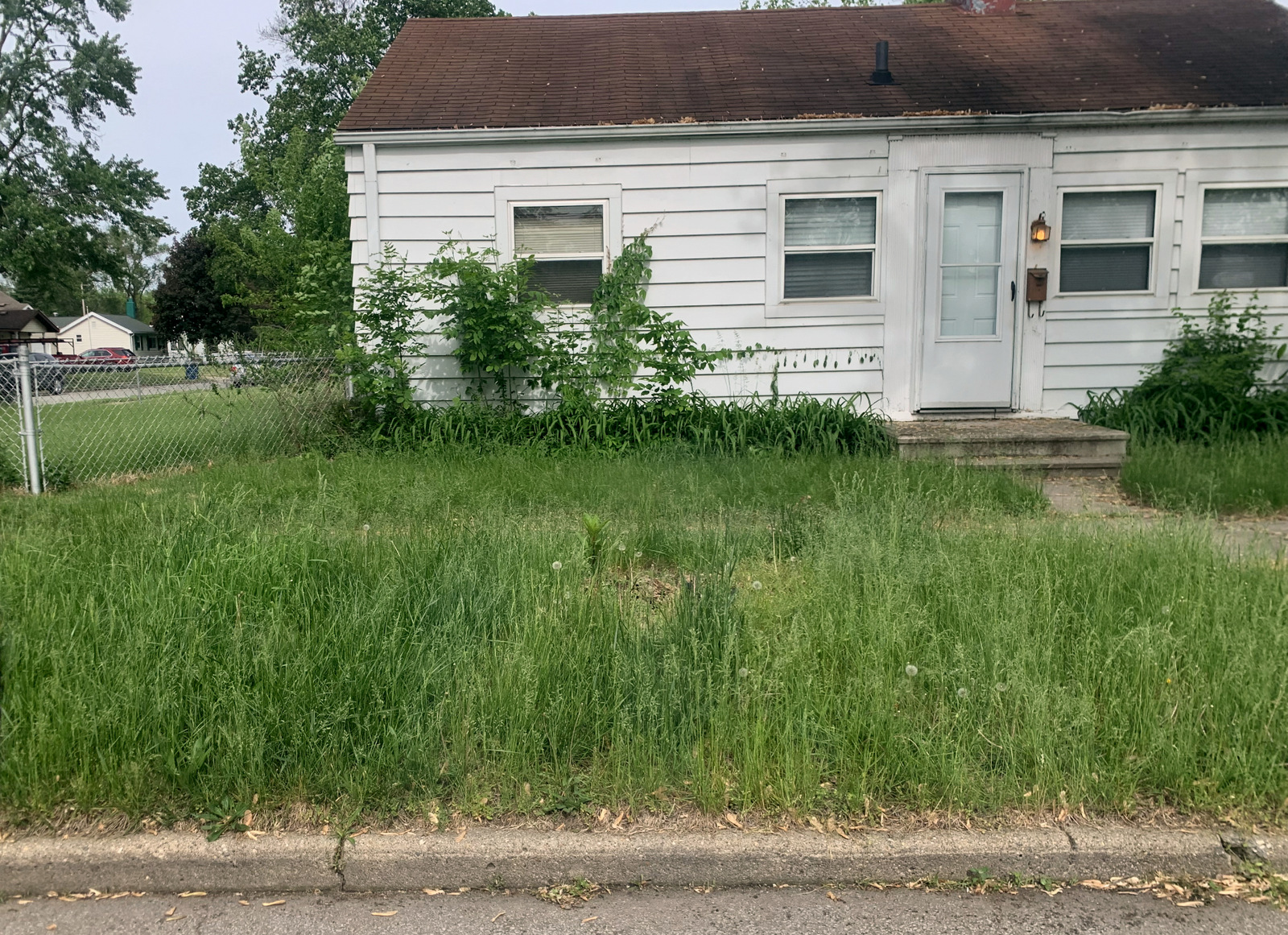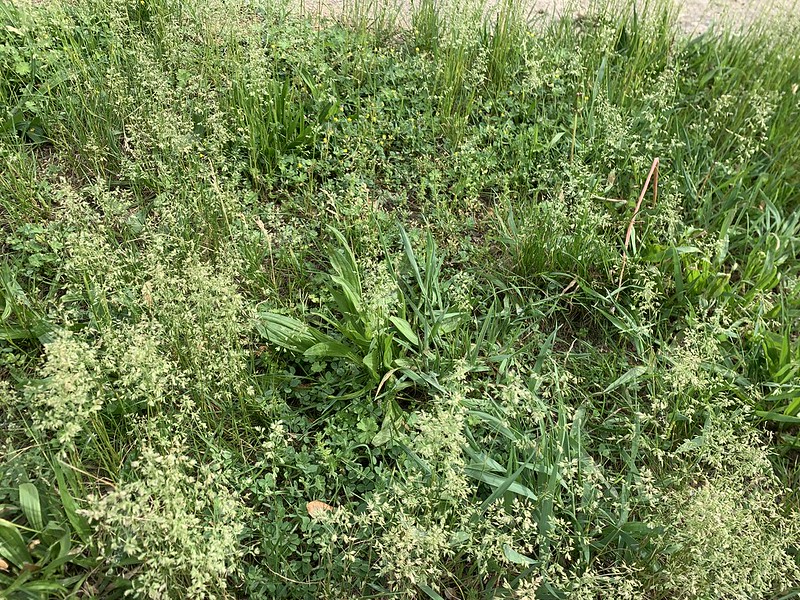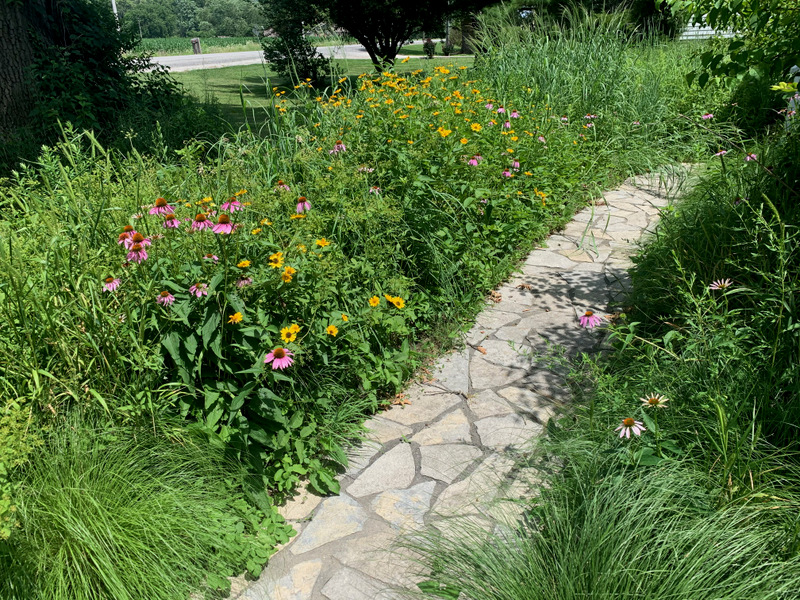ECOLOGY ▪ SCIENCE ▪ EDUCATION

Numerous sources indicate that the No Mow May campaign originated in the United Kingdom in 2019 as an initiative by the British charity Plantlife (Horton 2022, Shersby 2022). The organization refers to the initiative as “an annual campaign calling all garden owners and green space managers not to mow during May.” They reason, “By doing this your lawn benefits wildlife, tackles pollution and can even lock away carbon below ground” (Plantlife 2023).

The following year, the movement spread to the United States. Citizens in Appleton, Wisconsin, led by coordinator and Lawrence University assistant professor Israel Del Toro convinced the city’s common council to pass a resolution designating the month of May as “No Mow May,’ thus suspending enforcement of municipal code and “permitting all residents to voluntarily delay lawn-care and liter [sic] removal practices until June” (Appleton 2020, Fox 11 News 2020). Concurrently, Professor Del Toro, and colleague Relena Ribbons, produced an often-cited supporting study published in the scientific journal Peerj titled, “No Mow May lawns have higher pollinator richness and abundances: An engaged community provides floral resources for pollinators.”
Following Peerj’s publication of the study, the No Mow May movement grew considerable traction. On their website, Bee City USA, an initiative of the Xerces Society, touted the study’s results as evidence to support the ecological benefits of No Mow May (Bee City USA 2021a). Media outlets such as The New York Times (Readel 2022a) and PBS Wisconsin (Freyberg 2022) covered the movement and the study. Currently, over two dozen cities have adopted No Mow May resolutions, with some such as Albion, Michigan (Albion 2022); Bangor, Maine (Bangor 2023); Ann Arbor, Michigan (Ann Arbor 2022); and Edina, Minnesota (Edina 2022), directly quoting from the Del Toro and Ribbons study or mentioning the results of unnamed research as part of their rationale. In March 2022, Appleton went further and permanently codified No Mow May, citing the study in the text of their resolution (Appleton 2022).
Not everyone was quick to accept the results of the Del Toro and Ribbons study. In a blog post titled “Documenting serious issues in a bee paper on ‘No Mow May,’” University of Minnesota bee taxonomist Zachary Portman wrote that the paper “had such serious issues that I [Portman] took the step of alerting the journal” (Portman 2022). Portman summarized his concerns into two main categories:
Additionally, Dr. Portman called attention to the fact that the study referenced plants unlikely to bloom in the study area in May, misspelled numerous species names, and cited inadequate sources such as regional checklists as their bee identification resources.
Twenty-six months after alerting PeerJ of his concerns, the Del Toro and Ribbons study abruptly fell from grace. On November 18, 2022, the journal retracted the study stating that they found “several potential inconsistencies in data handling and reporting.” Following their retraction, The New York Times redacted their story on Now Mow May to exclude the retracted study (Readel 2022b), and Bee City USA removed references to it on their website (Bee City USA 2021b).
Citing the lack of scientific evidence, in March 2023, Appleton Alder Chad Doran filed a resolution to “eliminate the No Mow May program,” which he described as “divisive” (Charniak 2023) “and delete references to it from the city code” (Appleton 2023). Ultimately, the resolution didn’t pass the council committee and drew ire from the authors of the retracted paper, with Ribbons calling it “a form of bullying,” Del Toro accusing Doran of trying to “just bring attention to himself,” and stating that the results of a new study will soon be published (Behnke 2023).
Does No Mow May live up to the hype? Given its increasing media attention and viral spread, coupled with a relative absence of critical analysis, the need to objectively weigh the benefits and drawbacks of the movement became increasingly apparent. In doing so, we factored in the scientific/ecological, and cultural aspects. Not part of No Mow May’s claim, but sometimes included in its defense, we found the potential human health implications relevant to our analysis.



Worldwide, insects are in steep decline, and it’s not just those who pollinate either. A 2019 paper published by the journal Biological Conservation looked at 73 historical reports of insect decline and concluded that up to 40% of the world’s insect species are at risk of extinction over the next few decades (Sánchez-Bayo and Wyckhuys 2019). The authors listed, by order of importance, the reasons for the decline:
For the most part, conservation-minded individuals agree on ways to reduce these factors related to insect decline. We understand the consequences of pesticides and herbicides. We take steps to reduce our carbon footprint and are careful not to help spread invasive species.
Regarding habitat, property owners can also make a difference in their communities. Scientists have well-documented the importance of native plants as food sources for native insects (Ehrlich and Raven 1964, Tallamy et al. 2020). They also recognize that some genre of plants are more productive than others at providing food and shelter and that lawn is not an ecologically-sustainable habitat (Hostetler and Main 2010, Hostetler and McIntyre 2001, Tallamy 2007).
Experts and conservation organizations recommend methods that improve wildlife friendliness in residential and commercial landscapes. The Natural Resources Defense Council (Talbot 2016), National Audubon Society (NAS 2016), and the website homegrownnationalpark.org (HNP 2023) are among those who recommend shrinking the size of lawn areas, adding native plants, and removing invasive species. The NRDC also cautions about the potential influx of invasive and undesirable species in no-mow areas and recommends frequent weeding. Additionally, the National Wildlife Federation maintains lists of keystone (most critical) native plant species by ecogregion (NWF 2023).

Although well-intended, given everything we currently know about No Mow May, particularly the lack of supporting science coupled with concerns over potentially detrimental environmental and cultural impacts, precludes us from endorsing the movement as scientifically factual or even good practice. Hypotheses such as those benefits claimed by supporters of No Mow May require much greater study than what has been conducted. Not only is further research necessary, but to be credible, this research must come from independent entities who lack professional conflicts of interest with the results.
Within human habitations, the long-term health of pollinators and other wildlife are better served by planned and maintained native plant gardens instead of unsightly, short-lived habitat dominated by exotic wind-pollinated plant species.
[AAFA] Asthma and Allergy Foundation of America Community Services. 2021. What If You’re Allergic to Grass? 11 Steps to Managing Grass Pollen Allergy. Asthma and Allergy Foundation of America. [accessed 2023 Apr 18]. https://community.aafa.org/blog/what-if-you-re-allergic-to-grass-10-steps-to-managing-grass-pollen-allergy.
Albion, Mich. Res #2022-20 (2022).
Allergyinsider. 2021. Kentucky bluegrass Allergen Facts, Symptoms, and Treatment. Allergyinsider. [accessed 2023 Apr 18]. https://www.thermofisher.com/allergy/us/en/allergen-fact-sheets.html?allergen=kentucky-bluegrass#:~:text=While%20valued%20as%20pasture%20and,serious%20pollinosis%20(hay%20fever).
Ann Arbor, Mich. Res #22-0613 (2022).
Appleton, Wisc. Res #2-R-20 (2020).
Appleton, Wisc. Res #3-R-22 (2022).
Appleton, Wisc. Res #2-R-23 (2023).
Bangor, Me. Res #23-101 (2023).
Bauer S, Reyes J. 2018. Mowing practices for healthy lawns. University of Minnesota Extension. https://extension.umn.edu/lawn-care/mowing-practices-healthy-lawns.
Bee City USA. 2021a. No Mow May. webarchiveorg. [accessed 2023 Apr 7]. https://web.archive.org/web/20210420005233/https://beecityusa.org/no-mow-may/.
Bee City USA. 2021b. No Mow May. Bee City USA. [accessed 2023 Apr 8]. https://beecityusa.org/no-mow-may/.
Behnke D. 2023. Appleton committee rejects effort to end No Mow May; Lawrence professors criticize proposal. The Appleton Post-Crescent. [accessed 2023 Apr 14]. https://www.postcrescent.com/story/news/local/2023/04/10/appletons-no-mow-may-withstands-scrutiny-brought-by-council-member/70099374007/.
Cadloff EB. 2022. Why More Americans Are Rethinking Their Lawns. Modern Farmer. [accessed 2023 Apr 1]. https://modernfarmer.com/2022/05/american-lawns-no-mow-may/.
Catalyststuff. 2023. Cute bee flying cartoon vector icon illustration. [accessed 2023 Apr 17]. https://www.freepik.com/free-vector/cute-bee-flying-cartoon-vector-icon-illustration-animal-nature-icon-concept-isolated-premium-vector_31641108.htm#query=bee%20cartoon&position=1&from_view=keyword&track=ais%22%3EImage%20by%20catalyststuff.
[CDC] Center for Disease Control. 2019. Preventing ticks in the yard | CDC. Centers for Disease Control and Prevention. [accessed 2023 Apr 16]. https://www.cdc.gov/lyme/prev/in_the_yard.html.
Charniak R. 2023. Appleton’s “No Mow May” Could be Cut. WTAQ News Talk | 975 FM · 1360 AM | Green Bay, WI. [accessed 2023 Apr 2]. https://wtaq.com/2023/03/16/612152/.
Del Toro I, Ribbons RR. 2020. No Mow May lawns have higher pollinator richness and abundances: An engaged community provides floral resources for pollinators. PeerJ. 8(1):e10021. doi:https://doi.org/10.7717/peerj.10021. [accessed 2023 Apr 7]. https://www.researchgate.net/publication/344340220_No_Mow_May_lawns_have_higher_pollinator_richness_and_abundances_An_engaged_community_provides_floral_resources_for_pollinators.
Duble RL. 2023. Kentucky Bluegrass. Aggie Horitculture. [accessed 2023 Apr 13]. https://aggie-hort.tamu.edu/plantanswers/turf/publications/Bluegrass.html.
Edina, Minn. Res #2022-24 (2022).
Ehrlich PR, Raven PH. 1964. Butterflies and Plants: A Study in Coevolution. Evolution. 18(4):586. doi:https://doi.org/10.2307/2406212.
Fox 11 News. 2020. Appleton kicks off “No Mow May.” WLUK. [accessed 2023 Apr 6]. https://fox11online.com/news/local/appleton-kicks-off-no-mow-may.
Freyberg F. 2022. Protecting Pollinators with “No Mow May.” PBS Wisconsin. [accessed 2023 Apr 8]. https://pbswisconsin.org/watch/here-and-now/protecting-pollinators-no-mow-may-uh0nac/.
Harris S. 2022. Beware “No-Mow April.” Greenbelt Online. [accessed 2023 Apr 13]. https://www.greenbeltonline.org/beware-no-mow-april/.
[HNP] Homegrown National Park. 2023. 10 Things to Get You Started by Doug Tallamy. Homegrown National Park. [accessed 2023 Apr 25]. https://static1.squarespace.com/static/5e601a118f2947710b9793da/t/614b7df186cbf41a2a6dd24c/1632337393924/SHRINK+THE+LAWN.pdf.
Horton H. 2022. Mow problem: gardeners encouraged not to cut lawns in May. The Guardian. [accessed 2023 Apr 1]. https://www.theguardian.com/environment/2022/apr/29/no-mow-may-gardeners-not-to-cut-lawns-wild-plants-insects.
Hostetler ME, Main MB. 2010. Native Landscaping vs. Exotic Landscaping: What Should We Recommend? Journal of Extension. 48(5). https://archives.joe.org/joe/2010october/pdf/JOE_v48_5comm1.pdf.
Hostetler NE, McIntyre ME. 2001. Effects of urban land use on pollinator (Hymenoptera: Apoidea) communities in a desert metropolis. Basic and Applied Ecology. 2(3):209–218. doi:https://doi.org/10.1078/1439-1791-00051.
Invasive.org. 2018a. ground ivy, Glechoma hederacea L. invasiveorg. [accessed 2023 Apr 12]. https://www.invasive.org/browse/subinfo.cfm?sub=3026.
Invasive.org. 2018b. Canada thistle, Cirsium arvense. invasiveorg. [accessed 2023 Apr 11]. https://www.invasive.org/browse/subinfo.cfm?sub=2792.
Invasive.org. 2018c. goutweed, Aegopodium podagraria Apiales: Apiaceae. invasiveorg. [accessed 2023 Apr 12]. https://www.invasive.org/browse/subinfo.cfm?sub=11534.
Lerman SB, Contosta AR, Milam J, Bang C. 2018. To mow or to mow less: Lawn mowing frequency affects bee abundance and diversity in suburban yards. Biological Conservation. 221:160–174. doi:https://doi.org/10.1016/j.biocon.2018.01.025. [accessed 2023 Apr 18]. https://www.sciencedirect.com/science/article/abs/pii/S0006320717306201.
Lerman SB, D’Amico V. 2019. Lawn mowing frequency in suburban areas has no detectable effect on Borrelia spp. vector Ixodes scapularis (Acari: Ixodidae). Stevenson B, editor. PLOS ONE. 14(4):e0214615. doi:https://doi.org/10.1371/journal.pone.0214615. [accessed 2020 Oct 9]. https://journals.plos.org/plosone/article?id=10.1371/journal.pone.0214615.
Loper GM, Cohen AC. 1987. Amino Acid Content of Dandelion Pollen, a Honey Bee (Hymenoptera: Apidae) Nutritional Evaluation. Journal of Economic Entomology. 80(1):14–17. doi:https://doi.org/10.1093/jee/80.1.14.
[NAS] National Audubon Society. 2016. How to Make Your Yard Bird-Friendly. National Audubon Society. [accessed 2023 Apr 25]. https://www.audubon.org/news/how-make-your-yard-bird-friendly-0.
[NWF] National Wildlife Federation. 2023. Keystone Plants by Ecoregion. National Wildlife Federation. [accessed 2023 Apr 25]. https://www.nwf.org/Garden-for-Wildlife/About/Native-Plants/keystone-plants-by-ecoregion.
Portman Z. 2022. Documenting serious issues in a bee paper on “No Mow May.” Medium. [accessed 2023 Apr 8]. https://zportman.medium.com/documenting-serious-issues-in-a-bee-paper-on-no-mow-may-dd9b563feac0.
Readel A. 2022a. In Wisconsin: Stowing Mowers, Pleasing Bees. The New York Times. [accessed 2023 Apr 8]. https://web.archive.org/web/20220328091119/https://www.nytimes.com/2022/03/28/travel/no-mow-may-wisconsin.html.
Readel A. 2022b. In Wisconsin: Stowing Mowers, Pleasing Bees. The New York Times. [accessed 2023 Apr 8]. https://www.nytimes.com/2022/03/28/travel/no-mow-may-wisconsin.html.
Sánchez-Bayo F, Wyckhuys KAG. 2019. Worldwide Decline of the entomofauna: a Review of Its Drivers. Biological Conservation. 232(232):8–27. doi:https://doi.org/10.1016/j.biocon.2019.01.020. [accessed 2023 Apr 25]. https://www.sciencedirect.com/science/article/abs/pii/S0006320718313636.
Schanen E. 2022. No Mow May Could Backfires: Here’s Why. The Impatient Gardener. [accessed 2023 Apr 12]. https://www.theimpatientgardener.com/no-mow-may/.
Shersby M. 2022. No Mow May 2022: the best excuse for not mowing the lawn. Discover Wildlife. [accessed 2023 Apr 1]. https://www.discoverwildlife.com/how-to/wildlife-gardening/no-mow-may/.
[Sun Prairie] City of Sun Prairie Wisconsin. 2022. City of Sun Prairie 2022 Impact Report No Mow May. Sun Prairie (WI): City of Sun Prairie, Wisconsin. [accessed 2023 Apr 16]. https://cityofsunprairie.com/DocumentCenter/View/12917/No-Mow-May-Impact-Report-FINAL.
Tallamy DW. 2007. Bringing nature home : how you can sustain wildlife with native plants. Portland (OR): Timber Press.
Tallamy DW, Narango DL, Mitchell AB. 2020. Do Non-native Plants Contribute to Insect Declines? Ecological Entomology. 46(4). doi:https://doi.org/10.1111/een.12973.
Talbot M. 2016. More Sustainable (and Beautiful) Alternatives to a Grass Lawn. Natural Resources Defense Council. [accessed 2023 Apr 25]. https://www.nrdc.org/stories/more-sustainable-and-beautiful-alternatives-grass-lawn?gclid=CjwKCAjw9J2iBhBPEiwAErwpea6wXBPPLsi7JH2Srv5BJ7E7H3hbhc-9FetGkRhi9Dn-J3OCX5He8hoCzpMQAvD_BwE.
[UCANR] University of California Agriculture and Natural Resources. 2017. Healthy Lawns — Cutting off one-third of the grass blade. University of California. [accessed 2023 Apr 13]. https://ipm.ucanr.edu/TOOLS/TURF/ESTABLISH/onethird.html#:~:text=No%20more%20than%20one%2Dthird.
[WDHS] Wisconsin Department of Health Services. 2018 Mar 12. Tick Bite Prevention. Wisconsin Department of Health Services. [accessed 2023 Apr 17]. https://www.dhs.wisconsin.gov/tick/bite-prevention.htm.
WebMD. 2022. Am I Allergic to the Pollen in Grass? DerSarkissian C, editor. WebMD. [accessed 2023 Apr 18]. https://www.webmd.com/allergies/grass-pollen-allergy.